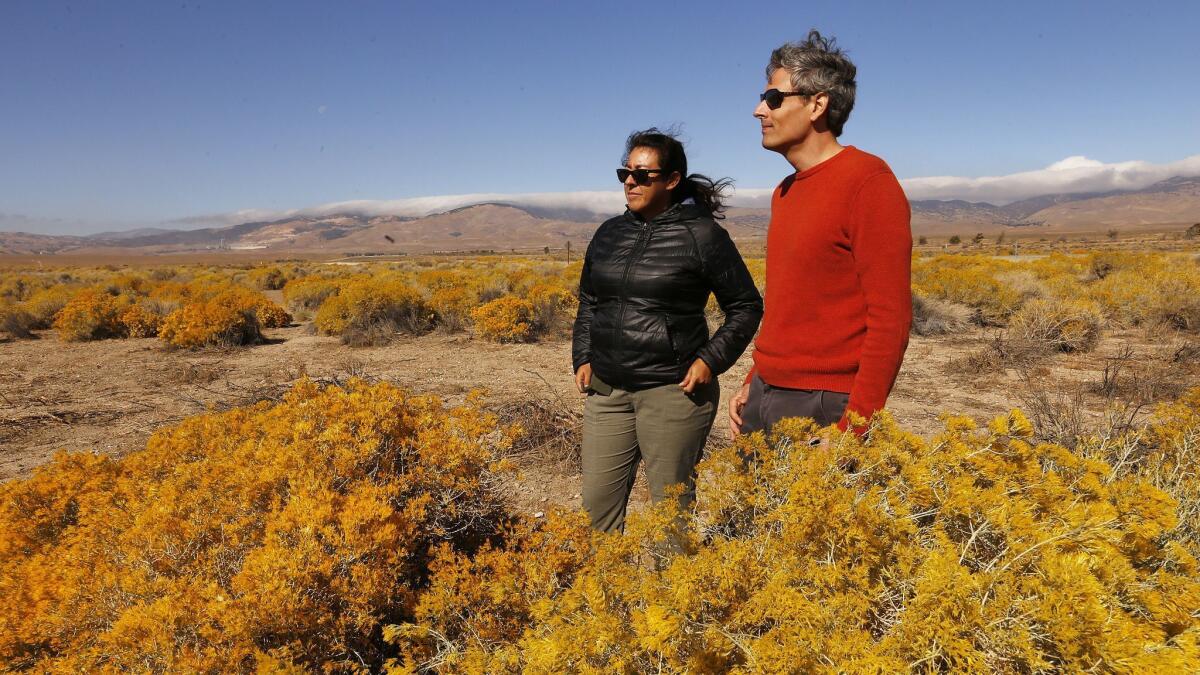A botanist criticized Tejon Ranch. So he got kicked out — along with 10,000 of his friends

- Share via
To fend off lawsuits over its plans to build a new city in the rugged countryside northwest of Los Angeles, Tejon Ranch Co. made a landmark concession to environmentalists.
It promised a decade ago to preserve 90% of its land — 240,000 acres — as an untouched ecological conservancy for public enjoyment through educational and research programs.
But as the 19,300-residence development seeks final approval from county supervisors as early as this week, Tejon Ranch Co. has banned a leading botanical group from visiting its environmental conservancy in what opponents say is a bid to stifle criticism.
The ban stems from negative appraisals of the potential impacts of the planned Centennial development on rare native bunch grasses and wildflowers by Nick Jensen, a conservation analyst for the nonprofit California Native Plant Society.
“I don’t want to see those grasslands paved over — and I said so in public comments submitted during the environmental review of Centennial,” said Jensen, 39, on a recent weekday as he waded through waist-high bright yellow rabbit brush just outside of the conservancy’s property line.
“For that, Tejon Ranch has come down pretty hard on us.”
Earlier this year, Tejon banned Jensen — along with his entire 10,000-member plant society and other botanical organizations it associates with — from accessing its wildlands in the Tehachapi Mountains about 60 miles north of downtown.
It’s a sharp about-face regarding Jensen, who had once been touted by the company for compiling a definitive list of plant species found on the conservancy.
Critics say the dispute has tarnished the conservancy’s image as a leader of habitat protection and access to some of California’s most striking terrain. It comes at a time when the Los Angeles County Board of Supervisors is preparing to vote on whether to certify Centennial’s environmental impact report and approve associated land-use plans and permits.
Barry Zoeller, vice president of corporate communications and investor relations for Tejon Ranch, defended the company’s action in a statement to The Times.
“This year, Tejon Ranch declined to continue providing access permits to members and individuals associated with the California Native Plant Society,” he said, “because of its public opposition to the Centennial development” and affiliation with the Center for Biological Diversity, a current and former litigant against the company.

“Access is managed in order to maintain stewardship of the land,” he added, “to avoid interference with ranch operations, and based on liability and business risk.”
Also banned was the Rancho Santa Ana Botanic Garden in Claremont, a nonprofit research organization with a charter that forbids taking a public stance on land-use issues.
“In our case, it is guilt by association with the native plant society,” said Naomi Fraga, director of conservation programs at the botanic garden. “The company is picking on folks who just like to roll around in the dirt looking at flowers.”
A small band of buckwheat enthusiasts known as the Eriogonum Society realized it was on the outs in June when a long-awaited field trip to Tejon Ranch was canceled due to its peripheral relationship with the native plant society.
“I wish I was writing with positive news because I know how much you and the others were looking forward to the Tejon Ranch portion of this weekend’s outing,” Ellery Mayence, senior ecologist and science program manager at the conservancy, informed the group in an email obtained by The Times.
“Tejon Ranch Co., the property owner and issuer of all ranch access permits,” Mayence said, “has pulled their support for the Eriogonum Society’s visit due to the society’s affiliation, however distant, with CNPS and Rancho Santa Ana BG.”

The situation has become a public relations issue for the conservancy and the company as they face two significant challenges: one centered on wildfire, the other on the finances.
In the aftermath of the Woolsey and Camp fires, questions have arisen about the wisdom of building a new city that would sit within “high” and “very high” fire hazard severity zones as defined by the California Department of Forestry and Fire Protection.
Meanwhile, the conservancy faces a potential budget squeeze. Its key operations — habitat enhancement, infrastructure maintenance, wildfire protection and public tours — are funded with interest-free loans of about $1 million a year that are provided by the company but scheduled to end in 2021.
Under an agreement, the conservancy was later to be funded through transfer fees from the sale of developments including Centennial’s residential properties. But anticipated property sales and construction projects were set back by the Great Recession of 2008, officials said.
“There will be a gap between the end of 2021 and a date at which transfer fees could materialize,” said Joel Reynolds, senior attorney for the Natural Resources Defense Council and chairman of the 12-member conservancy board.
“We’re doing everything we can to find alternative sources of income,” Reynolds said, “to carry out the conservancy’s responsibilities and keep it feasible.”
Other board members said the conservancy is discussing possible “shifts in priorities” to reduce operating expenses without jeopardizing goals and obligations.
The conservancy was set aside from development in perpetuity in a controversial 2008 agreement brokered between Tejon Ranch and a coalition of environmental groups including the Natural Resources Defense Council, Sierra Club, Audubon California and the Endangered Habitats League.
The agreement guarantees Tejon Ranch Co. the right to proceed with massive development projects on the remaining 10% of its holdings: Centennial; Grapevine, a master-planned community in southern Kern County; and Tejon Mountain Village, with spas, boutique hotels, commercial space, golf courses and estate homes, also in southern Kern County.
In exchange, the participating environmental groups promised not to fight the company’s development plans.

The deal established the largest chunk of privately owned wilderness in Southern California, overlapping biological zones including sandy desert, granite outcroppings, grasslands and forests. The diverse terrain creates a vast stronghold for bears, deer, elk, migrating birds and hundreds of species of trees, grasses and wildflowers.
Some environmental groups not part of the deal, including the Center for Biological Diversity, however, argue it will extend Southern California’s urban sprawl to the Central Valley, adding traffic and air pollution and harming federally endangered species such as the California condor.
J.P. Rose, urban wildlands attorney for the Center for Biological Diversity, said banning botanists who weren’t part of the deal suggests the company is willing to associate only with people who agree with it.
“Punishing people for participating in a public environmental review is undemocratic and has no place in our society,” Rose said.
In an ongoing legal challenge brought by the Center for Biological Diversity, a judge ruled in July that Kern County’s environmental review of Tejon’s Grapevine development was inadequate because it failed to disclose the potential effects of the project on air quality and public health.
It’s not the first time the ranch company has raised the ire of scientists and conservationists.
In 2012, Tejon Ranch agreed to pay $136,500 in fines and restitution for illegally killing at least 11 mountain lions to prevent them from competing for game with high-paying trophy hunters in its hunting concession.
Hunting generates up to $2 million a year in revenue for the company, with hunters paying up to $20,000 to shoot elk.
Elk aren’t the only prized species on the ranch.
Before his ban, Jensen recalled a time when a group of visiting botanists and students spotted “unusual flowers with whirls of green and maroon petals.”
“Someone yelled, ‘Stop the car!’ and we piled out for a closer look,” he said. “Our suspicion came to fruition. It was a new species of jewel flower, and it later figured prominently in my PhD dissertation.”
“That land is full of wildflowers just waiting to be discovered,” he said.
More to Read
Sign up for Essential California
The most important California stories and recommendations in your inbox every morning.
You may occasionally receive promotional content from the Los Angeles Times.











